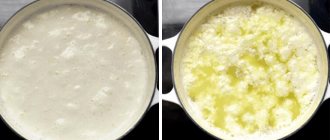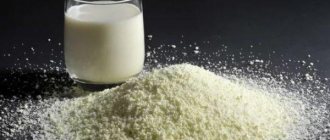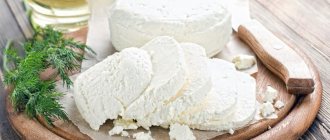Publication in the group: Dishes from cottage cheese, dairy products
Pasteurized milk is a product that has undergone high heat treatment. This means that the beneficial properties of vitamins in such milk are at least 2 times higher than in regular milk. This milk is very popular. According to a 2017 study in Finland, pasteurized milk consumption per person was more than 34 gallons per year. In Switzerland, despite the country's small area, there are more than 5,000 dairy farms. The Netherlands has 18,000 farms and more than 2 million cows, and dairy products are a national symbol.
During the production of milk in large volumes, there is a need for its high-quality processing, for which the pasteurization method is used. Boiling is a standard type of milk processing. Microbiologists of the 19th century. worked on the invention of a technology capable of purifying a liquid environment from harmful bacteria. The discoverer was Louis Pasteur. From him this method received the name of the same name.
During pasteurization, milk is systematically heated to 80° and held for 5 to 30 minutes. After such processing, beneficial enzymes remain in the milk, and harmful ones are destroyed, but studies have shown that the destruction of harmful microflora does not occur completely. Remains of microorganisms in the form of spores are stored in milk and, when favorable conditions are created, they can begin to develop.
Classification
Based on the content of useful components, pasteurized milk is divided into the following subtypes:
- Sterilized. Milk that has undergone strong heat treatment. It looks like melted butter. This milk is bottled. Its fat content is from 2.5% to 3.5%.
- Low-fat milk . This type of milk is produced by separation and liquefaction. The fat content in such milk is from 0.5% to 0.05%.
- Fortified milk . This special milk is made from whole milk or reduced-fat (low-fat) milk. During processing, it is additionally enriched with microelements and vitamins: A; C; D;
- Protein milk . This milk contains high concentrations of proteins and dry carbohydrates. This is a fermented milk product rich in vitamins:
- WITH;
- D;
- PP;
- B1–B6;
- B9;
- N.
Protein milk contains minerals such as:
- iron;
- iodine;
- potassium;
- magnesium;
- calcium.
All microelements are contained in a ratio that is beneficial for the human body:
- Baked milk. It is made by boiling and keeping in a closed container, deprived of sunlight for 6 - 8 hours. This milk contains a high concentration of fat – up to 6%.
- High fat milk . High fat milk is made from whole milk containing 6% fat.
- Reconstituted milk . This type of milk is prepared from canned milk. To prepare, powdered or whole milk is dissolved in warm water and infused for 3 to 4 hours to form protein compounds. After which the milk undergoes purification, homogenization and cooling.
- Whole milk . It is normal milk with a fat content of 2.5% to 3.2%.
Determining quality
When buying village milk, ask the owner for a certificate from a veterinarian. This question will not surprise her, because every cow owner must regularly show the animal to a doctor and have the milk tested. This certificate is a kind of quality certificate.
Store-bought milk should, in theory, meet the standards, but this is not always the case. You can check the quality yourself:
- Pour some milk into a clear glass or jar and add a few drops of food vinegar - if bubbles appear, the milk contains harmful additives.
- Add a couple of drops of iodine to a glass of liquid product - if it turns blue, it means it contains starch.
- Dip litmus paper into a glass - if it turns blue, there is soda in the liquid, and if it turns red, there are acidic impurities.
Calorie content, BJU
| Elements | Content per 100 g of product | Percentage |
| Squirrels | 2,47 | 3 |
| Fats | 2,90 | 3 |
| Carbohydrates | 4,47 | 1 |
| Calorie content | 56-58 kcal, 235 kJ. | 2 |
Optimal ratio of proteins, fats and carbohydrates:
| Squirrels | 45,4% |
| Fats | 25,1% |
| Carbohydrates | 29,5% |
Requirements for raw materials
The type of milk for ultra-pasteurization processing technology is selected organoleptically. The liquid should be whitish or creamy in color and free of flakes or sediment. Regulations prohibit the use of frozen drinks. Regarding the chemical content, it should not contain antibiotics, soda, hydrogen peroxide or ammonia.
To avoid irregularities in the production process, suppliers strictly check raw materials. This is also due to the high cost of the production line used in production. Poor quality raw materials can lead to equipment failure, as they curl when heated.
Benefit
Pasteurized milk means that the product has undergone heat treatment, lost pathogenic microorganisms and retained only beneficial ones.
Such milk will be amazed by the same beneficial properties as regular milk, but in addition to everything, they are enhanced by the pasteurization method:
- Pasteurized milk strengthens bone and tooth tissue. The macroelement calcium (Ca) is one of the main vitamins necessary for life support processes. It plays an important role in blood clotting, affects muscle mobility, controls the mechanisms of hormonal secretion, has a beneficial effect on digestion and improves sleep, and also strengthens the immune system.
- Contains macronutrient D. In order to absorb calcium (Ca), vitamin D must be present in the intestines; milk contains it in excess. Vitamin D helps absorb calcium and is involved in the synthesis of immune cells.
- Strengthens the immune system. Vitamin D, which is contained in pasteurized milk, helps in the functioning of the hematopoietic system and promotes the production of monocytes in the bone marrow - one of the most important immune cells of the body.
Pasteurized milk is very healthy for all people. - Eating pasteurized milk helps strengthen the heart muscle and blood vessels. Thanks to the high potassium content (Ka): 140-146 mg per 100 ml in the blood, the acid-base balance and water balance of the whole body is maintained. Potassium also improves brain function, affects the dilation of blood vessels, which reduces blood pressure.
- Eating pasteurized milk improves muscle mass. A high concentration of milk protein compounds, such as casein, ensures the strengthening of muscle fibers, their rapid recovery and growth under excessive loads. It is casein that gives milk its white color.
- Improves potency.
- Maintains the balance of magnesium and calcium in the body.
- Improves sleep status. Due to the increased saturation of protein compounds in pasteurized milk, the human body produces more intense sleep hormones, such as melatonin.
- The increased concentration of vitamin A in pasteurized milk has a beneficial effect on the skin.
Types of milk
Today there are six varieties of milk, but manufacturers often offer only two types: pasteurized and sterilized milk, each of which has its own characteristics, depending on the processing method.
The first option is sold exclusively in soft bags; its shelf life is quite short and reaches a maximum of a week. Sterilized, in a special hard Tetra Pak package, does not lose its beneficial properties for up to six months.
Pasteurized milk is the best choice for those who cannot buy country milk.
Pasteurization is based on the following - the required products are heated once to a temperature of 60 ° C for sixty minutes, or 30 minutes, but up to 80 ° C.
Harm
Pasteurized milk means that the product has undergone changes under the influence of high temperatures and the structure of macroelements in it has been affected, which can be harmful:
- Pasteurized milk is an autoimmune product. This means that it can harm the immune system if abused.
- Milk contains calcium that is not natural or human, but of animal origin, and it can be harmful to the body. This type of calcium is different from pure calcium. During pasteurization, calcium is converted into calcium phosphate. In the human body, it forms stones in the kidneys and pancreas.
- Pasteurized milk is a product with an increased concentration of lactose. In excessive quantities it is harmful to the gastrointestinal tract. During digestion, lactose breaks down into elements such as glucose and galactose. They do not leave the body, but are deposited at the joints, on bone tissue, accumulate in layers of subcutaneous fat, and can also cause stones in the bladder.
- Pasteurized milk is harmful for cardiovascular diseases. Pasteurized milk contains a high concentration of animal calcium. This element strengthens bone tissue and tooth enamel, but at high levels it forms excess salts in the human body, which form vascular plaques.
- Protein elements of animal origin, which richly pasteurized milk requires to be digested, require the release of greater amounts of acid than with regular milk, and this wears out the walls of the stomach faster.
- The pH value of the blood changes towards the acidic side with excessive consumption of pasteurized milk.
Details. Question answer
Is there anything useful left in the sterilized product?
Only some amino acids and minerals. It is advisable to use this type of processed milk for the population of remote areas, in field conditions.
Should pasteurized milk be boiled?
Pasteurized, which means freed from harmful bacteria and completely ready for consumption, does not require further boiling, and is safe for humans. Before sending milk to retail chains, dairy plants are required to test it for the presence of peroxidase. Its absence in the product indicates that all pathogenic bacteria have been destroyed.
IMPORTANT!
The only advice: slightly warm the milk when removing it from the refrigerator, since when warm it is more beneficial for the digestion process
Do I need to boil pasteurized milk for my baby?
Pasteurized milk is more suitable for children than others. It contains no preservatives, therefore it will not provoke any allergies. For preparing porridge it is suitable for six-month-old babies. And in a year you can try to give milk in its pure form.
IMPORTANT!
There is a small probability that even after pasteurization, microorganisms protected by a film resistant to heat treatment will not be destroyed. Although they may not be dangerous for adults, in the case of children it is not worth the risk; their digestive system is still too sensitive to this kind of irritants.
Pasteurization methods
Classification of methods to reduce the amount of harmful elements and bacteria:
- Simple pasteurization technique . Milk is heated to 60° in an hour or to 70°–80° in 30 minutes. With this treatment, most vegetative bacteria die, but the spores remain viable and can begin to develop.
- UHT technique. A method in which milk is subjected to stronger and sharper heat treatment. Ultra-pasteurization increases the quality of milk 5 times, and it does not require subsequent boiling. The milk is rapidly heated in 2 - 3 seconds, to a temperature of 130° - 140°, and then quickly cooled to 3° - 4°. Pathogens and harmful microflora are completely destroyed, but beneficial elements remain. After this treatment method, milk may not sour for more than 3 months.
- High or complete sterilization method . A method in which the complete elimination of all types of bacteria, both harmful and beneficial, is carried out in milk. Sterilization can be carried out by thermal, radiation, or technical filtration methods. When milk is sterilized, it is kept heated at boiling temperature for half an hour. After this, the composition loses most of its positive qualities, but the milk can be preserved and not sour for a long time.
The original function of this product is to feed a newborn.
Nature has designed it so that milk is the result of a normal physiological function of mammals. People have been using milk from cows, goats, horses and other animals for food for many centuries. Since milk, like eggs and meat, is a product of animal origin, it should not be consumed raw. During the milking process, particles of skin or blood inevitably get into it, and with them harmful bacteria.
Milk processing methods have been developed in dairy industries. At the primary stage, wool and foreign particles are removed. The filtered raw materials are homogenized, that is, using a special technological operation, a uniform distribution of fat is achieved throughout the entire volume of the product. The homogenization process helps to extend the shelf life of the product. Then it is normalized and pasteurized.
Pasteurization is the heating of milk to a hot state no higher than 78°-85° C and then rapid cooling. During this measure, dangerous microorganisms are destroyed. Pasteurization helps to increase the shelf life of milk up to 1 week.
Differences from sterilized, ultra-pasteurized
Sterilized milk undergoes stronger heat treatment than ultra-pasteurized milk. It is quickly heated to 100° and boiled for more than 10-15 minutes. As a result of this processing method, all microorganisms, both beneficial and harmful, are destroyed. During ultra-pasteurization, milk is driven through hot pipes, and it is heated to 137° in 4 seconds, after which it is sharply cooled to 3°-4°. During this process, harmful elements quickly die due to low heat resistance, while useful elements are preserved.
Milk treated in this way can be stored for six months.
Is it possible to pasteurize milk at home?
You can pasteurize liquids at home - if, for example, you have the opportunity to buy village cow's or goat's milk. You need:
- large saucepan;
- funnel;
- several bottles or jars with tight lids;
- fridge.
Important! Before the procedure, the pan must be washed very well, and it is better to sterilize the jars or bottles, as is usually done when canning.
Home pasteurization procedure:
- Pour milk into a saucepan.
- Bring it to a boil.
- Cool.
- Pour into jars.
- Close tightly..
- Place in the refrigerator on the bottom shelf or other cool, dark place.
Important! Milk treated in this way will remain fresh for about a week.
Storage period and conditions
Pasteurized milk means a high quality standard and long shelf life. Such milk can be stored longer than usual if it is sealed, there is no light and at low temperatures. It retains its beneficial properties for a long time, but after opening the package, the shelf life does not exceed 48 hours.
In order not to make a mistake when choosing high-quality pasteurized milk in the store, you need to take into account the weakening criteria:
- Place of production . Milk after long transportation may be subject to prolonged shaking and lose its beneficial properties.
- Best before date . Storage conditions and the date of milk bottling are what you should pay attention to first. These data must be clearly stated and not out of date.
- Compound . The composition and beneficial properties of milk are extremely important, as well as the presence of foreign elements and preservatives in it, which manufacturers can add to increase shelf life. All non-native elements in pasteurized milk harm its quality.
Once opened, pasteurized milk is susceptible to oxidation and exposure to sunlight. This means that it can quickly deteriorate and lose all its beneficial properties.
Boil the milk
Boiling is not a very difficult task, but it is responsible and requires attention. Milk can:
- run away;
- burn.
For boiling you need;
- large saucepan - glass or stainless steel;
- saucers;
- wooden spoon with a long handle.
Important! Dishes are a very important element:
- In an enamel pan, milk very often burns, so it is better to use steel or aluminum.
- Containers made of fireproof glass or ceramics are also suitable.
- It is better if the pan has a thick bottom.
How long to boil?
You need to boil the milk for a very short time, but during this time you should not leave the stove:
- Rinse the pan.
- Place an inverted saucer on the bottom.
- Pour milk.
- Place the pan on the fire.
- Wait until it boils.
- Boil for 2-3 minutes, skimming off the foam and stirring.
When boiling, you can add sugar at the rate of 1 teaspoon per 1 liter. This will increase the shelf life of the product.
Important! The foam is removed only during boiling - when the milk has cooled, there is no need to remove the film, because there are many useful substances left in it.
Instant heating
There is also a fairly simple pasteurization method called flash pasteurization. This process was developed for mothers who have HIV infection and are unable to safely breastfeed their babies. The method is that you first need to make a water bath. A water bath is quick and easy. Take two pans of different sizes. Pour water into a larger pan and heat it on the stove, then place the smaller pan in the larger one. After this, pour the milk into a small saucepan, and as soon as the water boils, immediately remove the milk, ready for use and having undergone a short pasteurization process











